Inspired by Dave Newell's years of research
This article was published in the October, 2008 CORSA Communique.
As promised in Part 1 of this two-part series, Part 2 focuses on photo-documenting the many interesting differences in Corvairs produced in Switzerland, both those assembled there from 'Completely Knocked-Down' (CKD) units and those built in the U.S. or Canada but sold new in Switzerland as 'Single-Unit Packs' (SUPs). SUPs were brought into the country because GM Suisse did not make the full line of Corvairs and also to fill the time before Swiss Corvair production began each new model year. Several of these differences are shared with Belgian Corvairs and are so noted.
As described in the article on 1966 Canadian Corvair production, all CKD Corvair 'kits' were produced in Bloomfield, NJ from 1960-64. In 1965, production moved to Oshawa, ON. In 1967, CKD production returned to Bloomfield, NJ. CKDs were not produced after 1967. SUPs were produced in both Canada and the U.S. depending on the year and the tax situation with the importing countries.
One thing not previously mentioned is that 1968 was the last year of Chevrolet production in Switzerland, one year after Corvair production ceased there. In 1971 Vauxhall production ended, leaving just Opels being produced until the factory closed for good in 1975. Buick, Oldsmobile, and Pontiac had previously shut down many years earlier (1958, 1958, and 1959, respectively).Swiss Corvair features
Let's begin by summarizing the Swiss Corvair features that are different from those built for sale in North America:- GM Suisse builder's plate
- Clear turn signal lenses in front
- Metric speedometer and odometer
- Vehicle information tag
- VIN stamped on body
- Format for VIN
- Serial number stamped on engine block
- Locally-made upholstery door panels and carpeting
- Clock mounted in glove box door
- Rear window decal
- Owner's manual and warranty book in local languages
- Tire inflation label in local languages
GM Suisse builder's plate
One of the most visible differences in Swiss Corvairs is the GM Suisse badge affixed to the front body panel. I was impressed to find that so many of these badges survived on the cars that I encountered. The CKD badge proudly says 'Montage Suisse' (made in Switzerland) while the SUP badge displays the location of the GM Suisse factory.
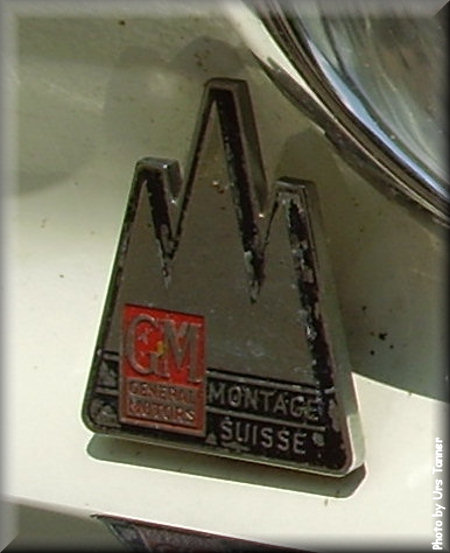
CKD badge for 1966 and earlier.
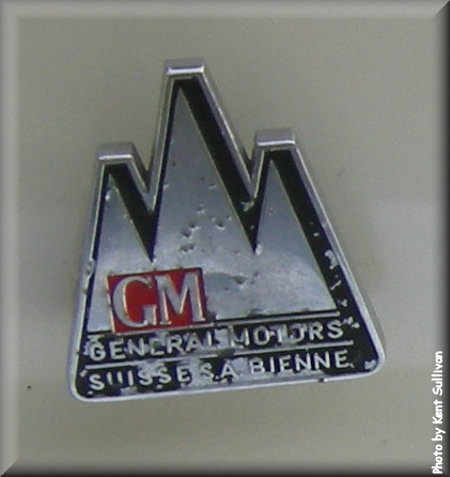
SUP badge for 1966 and earlier.
The design of both badges changed slightly in 1967. I didn't see a '67 SUP on my trips but Dave Newell has a badge from one in his collection (probably not from a Corvair, but the badges were the same for all GM Suisse products).
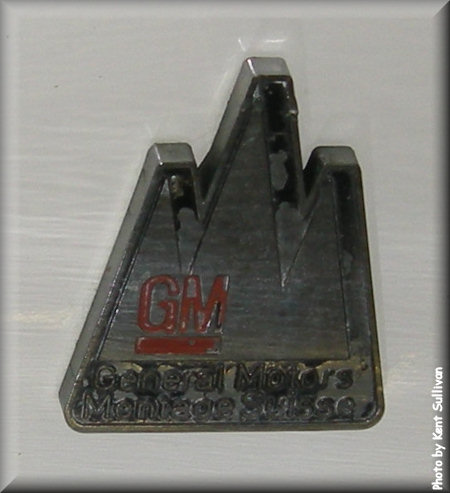
CKD badge for 1967.
Clear turn signal lenses in front
Also on the front end, the turn signal lenses are made of clear plastic rather than amber. Also, clear bulbs were used, not amber. This was a safety requirement. On all early model Swiss cars, the lenses were the same as those used on 1960-2 Corvairs produced in the US and Canada. For late models, clear lenses were made in the US and exported.
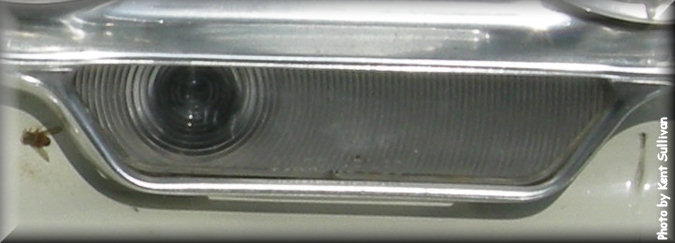
Driver's side front turn signal lens, 1964 and earlier.

Driver's side front turn signal lens, 1965 and later.
When I showed an example of these lenses at my local club meeting in the US, I was surprised that several members were quite interested in having a pair of them, to update their Corvairs to a "modern" look. What was old is new again, I guess! Maybe there's an opportunity for someone to produce clear lenses...
Belgian Corvairs use the same lenses.
(updated January 2009) Metric speedometer and odometer
Even though my brain tells me that Swiss Corvairs can't go any faster, seeing higher numbers on the speedometer sure makes it feel that way! I was fortunate to see examples of all of the speedometers in metric form, including the quite rare Spyder and Corsa models, since those cars were only imported in small numbers.

Early model metric speedometer.
It's not completely clear how many different speedometers were used in Spyders. To date, we have seen only three examples and they are all different! First, in a '63 Spyder coupe, is a speedometer with a 180 KPH max speed. Next are two '64 Spyder speedometers: one with a 190 KPH top speed and the other showing 200 KPH. Both 190 KPH and 200 KPH are roughly equivalent to 120 MPH, the max for all US Spyder speedometers (190 KPH = 118 MPH; 200 KPH = 124 MPH).
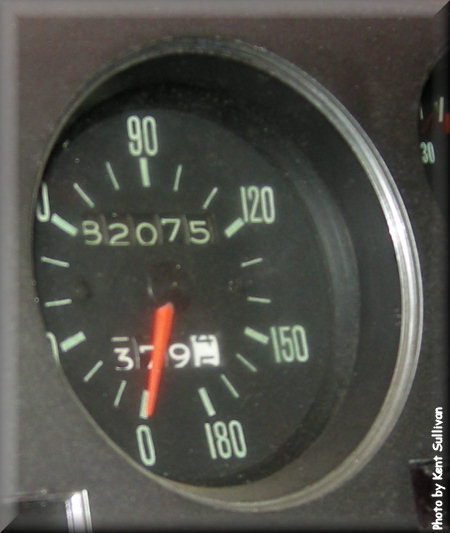
1963 Spyder metric speedometer.
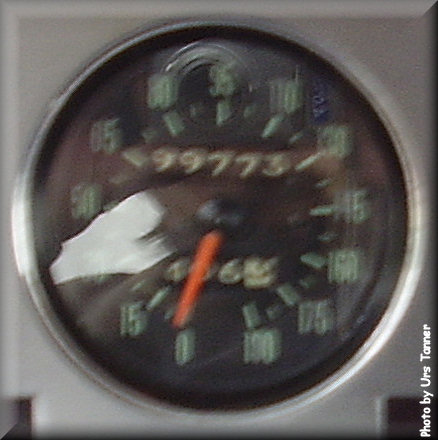

Two 1964 Spyder metric speedometers.
Interestingly, some of the speedometers featured lower top speeds than their US equivalents. The '63 Spyder coupe's limit of 180 KPH (112 MPH) is a full 8 MPH lower than the 120 MPH max used for all three years of Spyders in the US. The two Corsas I saw, one a '65 and the other a '66, both have speedometers with a top speed of 200 KPH (124 MPH), a full 16 MPH lower than their US counterparts.
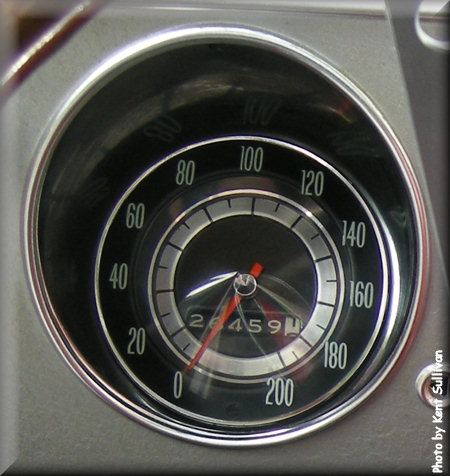
Late model metric speedometer and odometer.
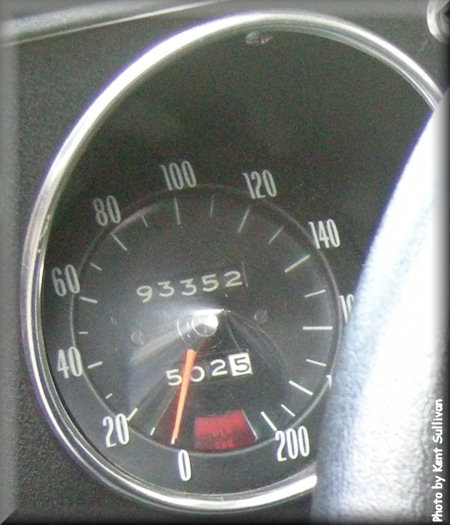
Corsa metric speedometer and odometer.
Trivia: A close-up picture of a 1966 Swiss SUP Corsa dash forms the front and rear covers of the GM Suisse full-line catalog for that year. The rear cover is dominated by a huge image of the 200 KPH speedometer.
Belgian Corvairs used the same metric speedometers, except possibly for Spyders. More research needs to be conducted for that model.
(updated January 2009) Vehicle information tag
The vehicle information tag is like a combination of the VIN tag and Fisher Body tag for US-built cars plus some unique fields, some of which we don't know the exact meaning of at this date.
The tags are generally rectangular in shape, although the one 1960 Corvair found so far has a square tag.
The tags have inconsistent mounting locations. On early models, they are often found on top of the left rear inner fender, in the engine compartment, just behind the battery box. In this location, sometimes they are mounted with the long side of the tag parallel to the rear of the car and sometimes parallel to the side of the car. On some early models, they are found on the rear frame rail in the engine compartment, which is where the tags are found on late models.
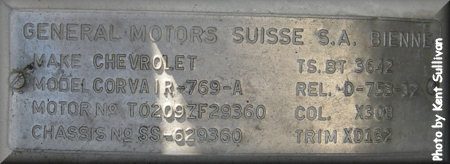
Vehicle information tag for a '62 CKD.
The engine compartments for SUPs get quite crowded with tags. The Swiss vehicle information tag is present plus tags from the country where produced (Fisher Body and VIN tag for US; body tag and VIN tag for Canada).
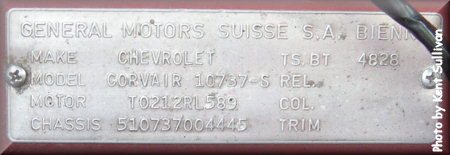
Vehicle information tag for a '65 SUP built in Canada.
Belgian Corvairs used a similar vehicle information tag, with some different fields. Two examples, from cars documented elsewhere on this site: a '66 CKD Corsa coupe and a '66 SUP Monza coupe. Tags for 1967 Belgian Corvairs are somewhat different. For example, the engine number field is no longer present.
(updated January 2009) VIN stamped on body
In addition to the VIN (known as the 'chassis number' in Switzerland) being displayed on the vehicle information tag, the VIN is also stamped directly on the left rear frame rail next to the battery box. This is somewhat different from the hidden serial number stamped on US-built cars since the complete VIN is stamped and it is in a very visible location. The orientation of the stamp varies from car to car. Usually one can read it by standing at the rear of the car but some stamps are flipped over, so reading them is best done by leaning over the left fender.
On CKDs, the VIN stamped on the body takes the place of the VIN tag found on US and Canadian Corvairs.

VIN stamp on a '64 CKD.
However, Chevrolet made no attempt to cover the location for the standard VIN tag. The indentation and holes are very visible on early model driver's door frames (albeit with rivets inserted to fill the holes).
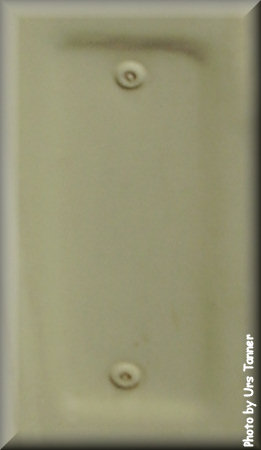
Empty standard VIN tag location on driver's door frame of a '63 CKD, with rivets.
On late models, the holes in the engine frame rail are left unfilled. It's just the engine compartment, so I guess a few more holes were no big deal!

VIN stamp on a '67 CKD. Note empty holes for standard VIN tag.
On SUPs, the standard VIN tag is also present, so these cars have two visible VINs. In the case of late models, they are within inches of each other in the engine compartment.

VIN tag and stamp on a late model SUP (with leading digit cut off by photographer, oops).
Belgian Corvairs follow the same pattern.
(updated January 2009) Format for VIN
The VIN (chassis number) for CKDs begins with 'SS-' (except for 1967, which begins with 'S9-'), followed by the last two digits of the model year, followed by a four-digit serial number that begins each year with 9001, indicating the build sequence within Corvairs of that model year. Other GM lines assembled in Switzerland used a different range for the serial number. Camaro serial numbers, for example, begin with 5001. SUPs use the VIN as assigned by the country where built (US or Canada).
Belgian Corvairs use the format of the country that provided CKDs and SUPs to them for any given year, with a "CA-" prefix for Continental Antwerp. CKD VINs had an 'X' or "GX" in place of the US assembly plant code letter. SUP VINs sometimes are slightly shortened versions of the original, e.g., removing leading zeroes from the serial number.
(updated January 2009) Serial number stamped on engine block
Similar to what was introduced in the US in 1968, appended to the code stamped on the top rear center of the engine block is a serial number for the car. For CKDs, almost the full chassis number is appended, just lacking the 'SS' or 'S9' and the leading year digit ('6'). For SUPs, a number representing this car's place in the sequential order of Swiss Corvair SUPs is used, presumably starting with 1 for the first Corvair SUP sold in 1960. The complete engine code is also featured on the body information tag, making it easier for anyone to check whether the original engine is present.

CKD engine code, as stamped on engine block.
However, the one '67 Swiss Corvair we have fully documented, a CKD, does not have the serial number appended. The engine number listed on the Swiss vehicle information plate has the same number, so the engine is definitely original. We don't know why the practice apparently stopped in 1967.

SUP engine code, as stamped on engine block.
Belgian Corvairs appear to follow this same pattern general pattern: sequential number for SUPs (although this appears to be per year) and serial number for CKDs. However, we need more data from various years to be sure.
Locally-made upholstery and door panels
CKDs feature upholstery, door panels, and carpet made in Switzerland. This unique upholstery was supplied and sewn by GM Suisse. Chevy II CKDs even had folding rear seat center armrests, which weren't offered on US and Canadian cars.
1960-4 Corvairs used a uniquely Swiss all-vinyl seat upholstery pattern and a door panel pattern similar to the 1960 US second design but without the white stripes.
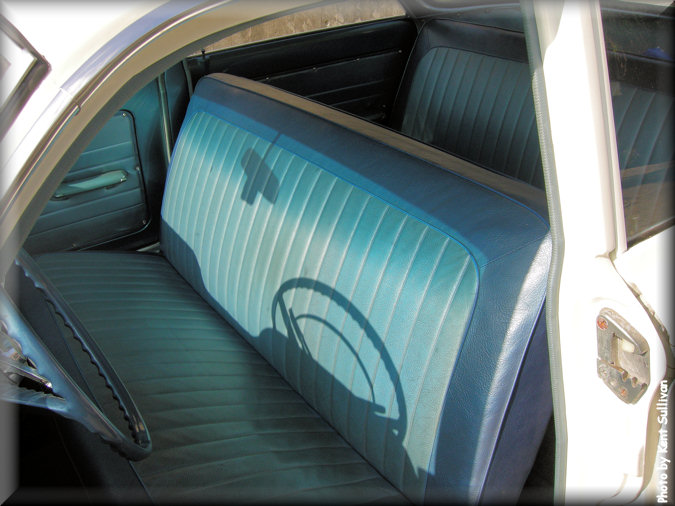
Upholstery from a '62 CKD.

Door panel from a '64 CKD.
1965-7 Corvairs used the 1965 US Monza upholstery pattern but with sewn pleats and US 1965 door panels. In 1967, the 1965 Monza pattern was adapted to the 500 bench seat.
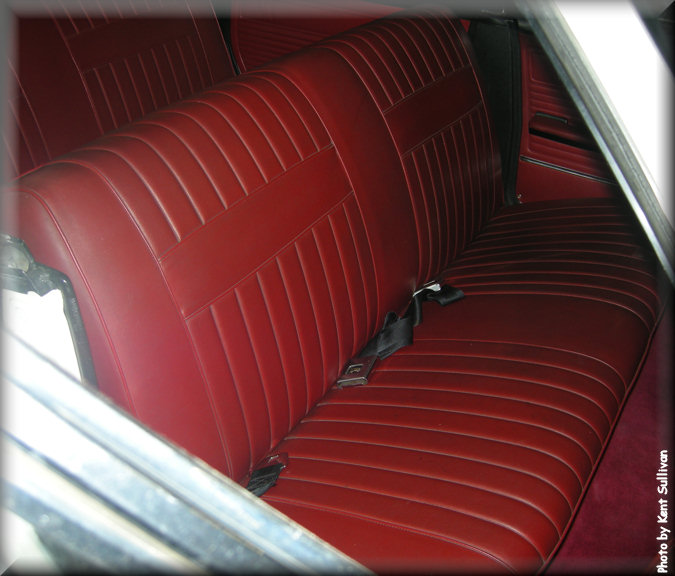
Upholstery from a '67 CKD.
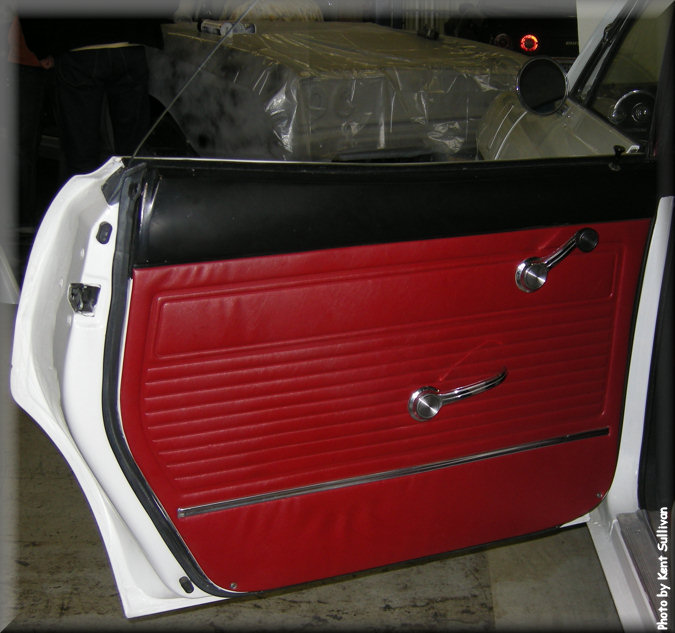
Door panel from a '67 CKD.
Belgian CKD Corvairs use upholstery from the country of origin; it was not made locally.
(updated January 2009) Clock mounted in glove box door
All early-model CKDs and SUPs have a clock mounted in the glove box door. The clock is mounted on the left or right side of the door in order to not interfere with whichever glove box emblems are found on a particular car.
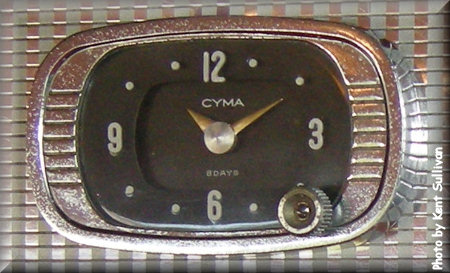
Clock mounted on the left side in a '62 SUP Monza coupe.
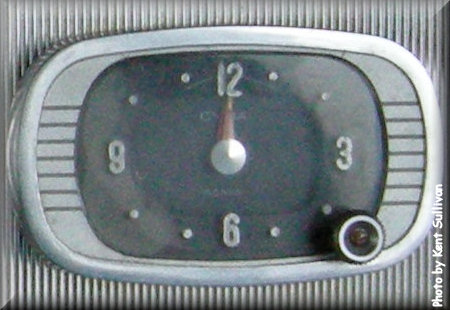
Clock mounted on the right side in a '64 CKD 700 sedan.
The clock is quite large. The case protrudes into the glove box about as deeply as the lock cylinder.
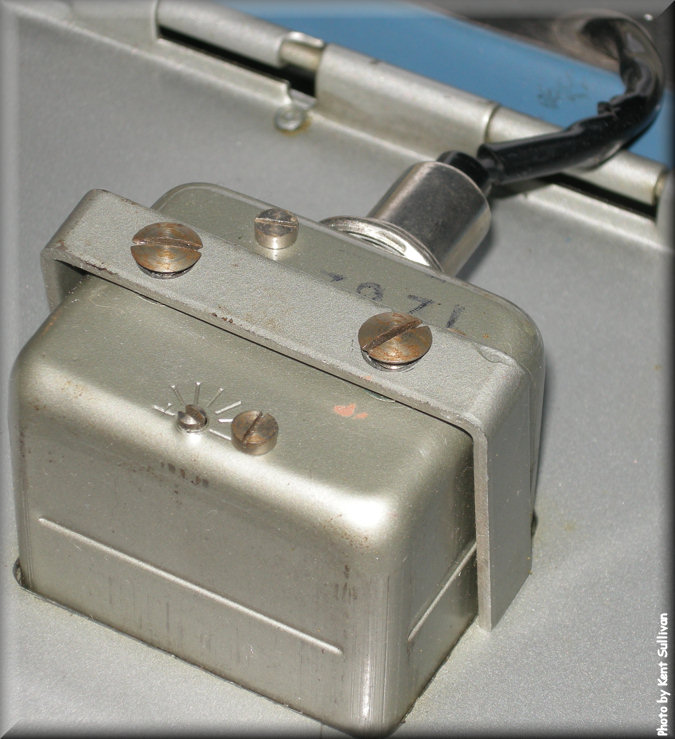
Back side of the clock shown in previous picture.
Dave Newell believes the clocks were chosen to add a touch of sophistication to cars, which were being marketed to Swiss professionals such as doctors, in the same class as the Mercedes Benz 220. This "up-market" strategy may also help explain why GM Suisse created their own all-vinyl upholstery for the early-model 700 CKDs, since those cars had cloth and vinyl interiors in the US and Canada.
Belgian Corvairs do not have a similar clock.
Rear window decal
The rear window of all Swiss Corvairs has a General Motors decal in the center. Very often these are missing today due to their fragile nature.

Rear window decal in a '64 CKD 700 sedan.
Belgian Corvairs have the same decal.
Owner's manual and warranty book in local languages
The owner's manual and warranty book are translated into German and French, reformatted, and printed for all CKDs and SUPs. GM Suisse printed the German version itself while GM Continental in Belgium printed the French version (imprinted with GM Suisse name and address). The two versions were formatted very differently.
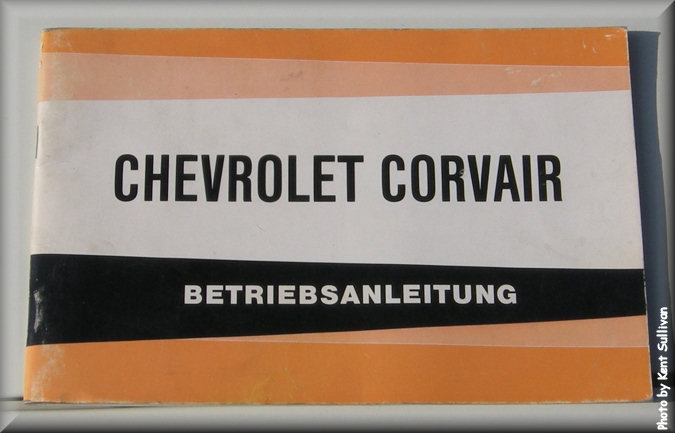
German-language owner's manual from a '62.
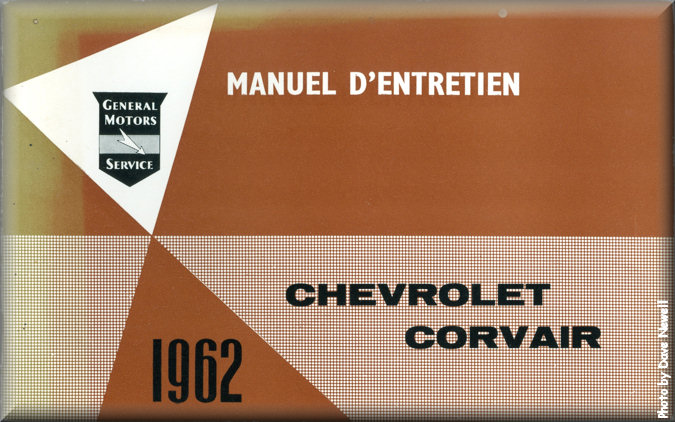
French-language owner's manual from a '62 (courtesy Dave Newell).

German-language warranty book (with owner's manual underneath) from a '64.
Belgian Corvairs used the same owner's manuals. As stated above, GM Continental printed the French versions itself. For the German version, GM Suisse replaced their contact info with GM Continental's before printing.
Tire inflation label in local languages
The familiar tire inflation label is translated into German and French (both languages on same decal) in all early model CKDs and SUPs. Some dealers (importers) added a second label explaining who to contact for warranty service.
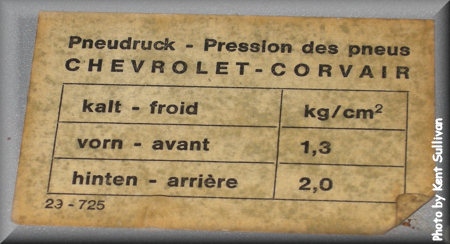
Tire inflation label from a '64 CKD 700 sedan in German and French.
The picture is less clear for late model cars. The ones seen so far have the same English label as in the US, but these may be reproductions.
Belgian Corvairs also featured a locally-made label in at least some years. This label was similar to but definitely different than the Swiss label. Here's an example from a '66 CKD Corsa coupe. We need to see more cars to understand what earlier years looked like.
Option configurations
In addition to Swiss-specific features, CKDs were configured with specific sets of options that were available in the US and Canada. SUPs also had specific option configurations, sometimes a bit different from CKDs.
As one example, in 1966, CKDs featured 140 HP engines with 4-speed transmissions and 3.27:1 Positraction differentials, telescopic steering columns, day/night inside rear view mirrors, spare tire locks, clear glass all around, rear seat belts deleted, and 7.00' x 13' blackwall nylon tires. Literature from Dave Newell shows the tires were whitewalls rated for 100 MPH continuous running and 105 MPH top speed, so the low-speed blackwall tires must have been replaced with European-sourced tires. We assume SUPs were configured similarly.
Swiss Corvair owners have found it very challenging to replace damaged windshields since it appears very few, if any, clear windshields were made as replacement stock, at least in recent years.
Other literature from Dave indicates that 1965 CKDs were similarly equipped. For 1967, the main change was the 110 HP engine replacing the 140 HP. Due to the lower horsepower, the differential was changed to 3.55:1 and was no longer Positraction, perhaps to save money since the model chosen was the low-buck 500. The telescoping steering column was also deleted, perhaps again to save money.
Thanks
This article would not have been possible without the many years of research by Dave Newell. Thanks also to Urs Tanner, Leon Janssen, Guus de Haan, and Jean-Philippe Bran for their research assistance.